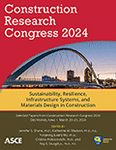Assessing the Vulnerability of Communities to Heat Waves: Developing a Heat Vulnerability Index
Publication: Construction Research Congress 2024
ABSTRACT
The construction of projects and buildings in urban areas leads to major transformation in the urban surfaces, where natural, pervious surfaces are transformed into rough, impermeable surfaces. This transformation leads to different environmental risks including the urban heat island (UHI) effect. Not all urban areas are equally affected by the UHI effect, which makes some areas more vulnerable to extreme heat waves. Thus, this paper develops a heat vulnerability index based on demographic, land use/land cover (LULC), meteorological, and geographic factors to assess heat vulnerability of communities. First, data for multiple meteorological, demographic, geographic, and LULC factors was collected. Second, four vulnerability sub-indices were developed. Third, the heat vulnerability index was developed as a weighted average of the four sub-indices, where the principal component analysis (PCA) method was implemented to calculate the weights of the factors as well as the sub-indices. The results reflected that LULC factors have the greatest impact on assessing heat vulnerability of communities. This research adds to the body of knowledge by helping authorities and decision-makers identify heat-vulnerable communities and ultimately developing immediate adaptation and mitigation plans for areas identified as highly vulnerable to heat events to address future harm from high temperatures.
Get full access to this article
View all available purchase options and get full access to this chapter.
REFERENCES
Abdrabo, K. I., Kantoush, S. A., Esmaiel, A., Saber, M., Sumi, T., Almamari, M., and Ghoniem, S. (2023). An integrated indicator-based approach for constructing an urban flood vulnerability index as an urban decision-making tool using the PCA and AHP techniques: A case study of Alexandria, Egypt. Urban Climate, 48, 101426.
Assaf, G., Hu, X., and Assaad, R. H. (2023a). Predicting Urban Heat Island (UHI) Severity on the Census-Tract Level Using Bayesian Networks. Sustainable Cities and Society, 104756.
Assaf, G., Hu, X., and Assaad, R. H. (2023). Mining and modeling the direct and indirect causalities among factors affecting the Urban Heat Island severity using structural machine learned Bayesian networks. Urban Climate, 101570.
Aneja, S., and Ghosh, A. (2019). Heat Vulnerability Index for Urban Heat wave Risk Adaptation for Indian Cities: A Case Study of Akola.
Åström, D. O., Bertil, F., and Joacim, R. (2011). Heat wave impact on morbidity and mortality in the elderly population: a review of recent studies. Maturitas, 69(2), 99–105.
Bao, J., Li, X., and Yu, C. (2015). The construction and validation of the heat vulnerability index, a review. International journal of environmental research and public health, 12(7), 7220–7234.
Chao, Z. (2021, January). A Review of the Innovation Capability of Guangdong, Hong Kong and Macao Greater Bay Area Based on Principal Component Analysis. In 2021 2nd International Conference on Education, Knowledge and Information Management (ICEKIM) (pp. 871–875). IEEE.
Distefano, N., Leonardi, S., and Liotta, N. G. (2023). Walking for Sustainable Cities: Factors Affecting Users’ Willingness to Walk. Sustainability, 15(7), 5684.
El-Zein, A., and Tonmoy, F. N. (2015). Assessment of vulnerability to climate change using a multi-criteria outranking approach with application to heat stress in Sydney. Ecological Indicators, 48, 207–217.
Fernandez, P., Mourato, S., Moreira, M., and Pereira, L. (2016). A new approach for computing a flood vulnerability index using cluster analysis. Physics and Chemistry of the Earth, Parts A/B/C, 94, 47–55.
Gaur, A., Eichenbaum, M. K., and Simonovic, S. P. (2018). Analysis and modelling of surface Urban Heat Island in 20 Canadian cities under climate and land-cover change. Journal of environmental management, 206, 145–157.
Huang, G., Zhou, W., and Cadenasso, M. L. (2011). Is everyone hot in the city? Spatial pattern of land surface temperatures, land cover and neighborhood socioeconomic characteristics in Baltimore, MD. Journal of environmental management, 92(7), 1753–1759.
Lim, J., and Skidmore, M. (2020). Heat vulnerability and heat island mitigation in the United States. Atmosphere, 11(6), 558.
Loughner, C. P., Allen, D. J., Zhang, D. L., Pickering, K. E., Dickerson, R. R., and Landry, L. (2012). Roles of urban tree canopy and buildings in urban heat island effects: Parameterization and preliminary results. Journal of Applied Meteorology and Climatology, 51(10), 1775–1793.
Makido, Y., Shandas, V., Ferwati, S., and Sailor, D. (2016). Daytime variation of urban heat islands: the case study of Doha, Qatar. Climate, 4(2), 32.
Mallen, E., Stone, B., and Lanza, K. (2019). A methodological assessment of extreme heat mortality modeling and heat vulnerability mapping in Dallas, Texas. Urban Climate, 30, 100528.
Martchamadol, J., and Kumar, S. (2013). An aggregated energy security performance indicator. Applied energy, 103, 653–670.
NJGIN Open Data. (2021). NJDOT revised urban area. Accessed April 25, 2023. https://njogis-newjersey.opendata.arcgis.com/maps/ed9dae64388f46d8abc2c867cd86b6e8/about.
Schmeltz, M. T., Sembajwe, G., Marcotullio, P. J., Grassman, J. A., Himmelstein, D. U., and Woolhandler, S. (2015). Identifying individual risk factors and documenting the pattern of heat-related illness through analyses of hospitalization and patterns of household cooling. PLoS One, 10(3), e0118958.
Schwarz, N., and Manceur, A. M. (2015). Analyzing the influence of urban forms on surface urban heat islands in Europe. Journal of Urban Planning and Development, 141(3), A4014003.
Tiwari, A., Kumar, P., Kalaiarasan, G., and Ottosen, T. B. (2021). The impacts of existing and hypothetical green infrastructure scenarios on urban heat island formation. Environmental Pollution, 274, 115898.
Weber, S., Sadoff, N., Zell, E., and de Sherbinin, A. (2015). Policy-relevant indicators for mapping the vulnerability of urban populations to extreme heat events: A case study of Philadelphia. Applied Geography, 63, 231–243.
Zhang, L., Shi, X., and Chang, Q. (2022). Exploring Adaptive UHI Mitigation Solutions by Spatial Heterogeneity of Land Surface Temperature and Its Relationship to Urban Morphology in Historical Downtown Blocks, Beijing. Land, 11(4), 544.
Information & Authors
Information
Published In
History
Published online: Mar 18, 2024
Authors
Metrics & Citations
Metrics
Citations
Download citation
If you have the appropriate software installed, you can download article citation data to the citation manager of your choice. Simply select your manager software from the list below and click Download.
